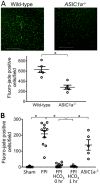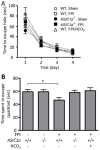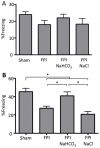Loss of Acid sensing ion channel-1a and bicarbonate administration attenuate the severity of traumatic brain injury
- PMID: 23991103
- PMCID: PMC3753246
- DOI: 10.1371/journal.pone.0072379
Loss of Acid sensing ion channel-1a and bicarbonate administration attenuate the severity of traumatic brain injury
Abstract
Traumatic brain injury (TBI) is a common cause of morbidity and mortality in people of all ages. Following the acute mechanical insult, TBI evolves over the ensuing minutes and days. Understanding the secondary factors that contribute to TBI might suggest therapeutic strategies to reduce the long-term consequences of brain trauma. To assess secondary factors that contribute to TBI, we studied a lateral fluid percussion injury (FPI) model in mice. Following FPI, the brain cortex became acidic, consistent with data from humans following brain trauma. Administering HCO3 (-) after FPI prevented the acidosis and reduced the extent of neurodegeneration. Because acidosis can activate acid sensing ion channels (ASICs), we also studied ASIC1a(-/-) mice and found reduced neurodegeneration after FPI. Both HCO3 (-) administration and loss of ASIC1a also reduced functional deficits caused by FPI. These results suggest that FPI induces cerebral acidosis that activates ASIC channels and contributes to secondary injury in TBI. They also suggest a therapeutic strategy to attenuate the adverse consequences of TBI.
Conflict of interest statement
Figures




Similar articles
-
Acid-Ion Sensing Channel 1a Deletion Reduces Chronic Brain Damage and Neurological Deficits after Experimental Traumatic Brain Injury.J Neurotrauma. 2021 Jun 1;38(11):1572-1584. doi: 10.1089/neu.2020.7568. Epub 2021 May 6. J Neurotrauma. 2021. PMID: 33779289
-
Molecular mechanism of constitutive endocytosis of Acid-sensing ion channel 1a and its protective function in acidosis-induced neuronal death.J Neurosci. 2013 Apr 17;33(16):7066-78. doi: 10.1523/JNEUROSCI.5206-12.2013. J Neurosci. 2013. PMID: 23595764 Free PMC article.
-
Acid-sensing ion channel 1a drives AMPA receptor plasticity following ischaemia and acidosis in hippocampal CA1 neurons.J Physiol. 2015 Oct 1;593(19):4373-86. doi: 10.1113/JP270701. Epub 2015 Aug 18. J Physiol. 2015. PMID: 26174503 Free PMC article.
-
Acid sensing ion channels--novel therapeutic targets for ischemic brain injury.Front Biosci. 2007 Jan 1;12:1376-86. doi: 10.2741/2154. Front Biosci. 2007. PMID: 17127388 Review.
-
Acid-Sensing Ion Channels and Mechanosensation.Int J Mol Sci. 2021 May 1;22(9):4810. doi: 10.3390/ijms22094810. Int J Mol Sci. 2021. PMID: 34062742 Free PMC article. Review.
Cited by
-
Drug development in targeting ion channels for brain edema.Acta Pharmacol Sin. 2020 Oct;41(10):1272-1288. doi: 10.1038/s41401-020-00503-5. Epub 2020 Aug 27. Acta Pharmacol Sin. 2020. PMID: 32855530 Free PMC article.
-
ASICs and neuropeptides.Neuropharmacology. 2015 Jul;94:36-41. doi: 10.1016/j.neuropharm.2014.12.012. Epub 2015 Jan 12. Neuropharmacology. 2015. PMID: 25592215 Free PMC article. Review.
-
Two aspects of ASIC function: Synaptic plasticity and neuronal injury.Neuropharmacology. 2015 Jul;94:42-8. doi: 10.1016/j.neuropharm.2014.12.010. Epub 2015 Jan 9. Neuropharmacology. 2015. PMID: 25582290 Free PMC article. Review.
-
Targeted Acid-Sensing Ion Channel Therapies for Migraine.Neurotherapeutics. 2018 Apr;15(2):402-414. doi: 10.1007/s13311-018-0619-2. Neurotherapeutics. 2018. PMID: 29549622 Free PMC article. Review.
-
miR-149 reduces while let-7 elevates ASIC1a expression in vitro.Int J Physiol Pathophysiol Pharmacol. 2017 Nov 1;9(5):147-152. eCollection 2017. Int J Physiol Pathophysiol Pharmacol. 2017. PMID: 29209451 Free PMC article.
References
-
- Faul M, Xu L, Wald MD, Coronado VG (2010) Traumatic brain injury in the United States: emergency department visits, hospitalizations, and deaths. In: Centers for Disease Control and Prevention NCfIPaC, editor. Atlanta, GA.
-
- Blennow K, Hardy J, Zetterberg H (2012) The neuropathology and neurobiology of traumatic brain injury. Neuron 76: 886–899. - PubMed
-
- Marion DW (1998) Head and spinal cord injury. Neurol Clin 16: 485–502. - PubMed
-
- Golding EM, Robertson CS, Bryan RM Jr (1999) The consequences of traumatic brain injury on cerebral blood flow and autoregulation: a review. Clin Exp Hypertens 21: 299–332. - PubMed
-
- Werner C, Engelhard K (2007) Pathophysiology of traumatic brain injury. Br J Anaesth 99: 4–9. - PubMed
Publication types
MeSH terms
Substances
Grants and funding
LinkOut - more resources
Full Text Sources
Other Literature Sources
Molecular Biology Databases

